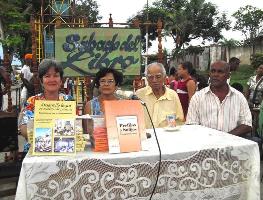
The Centre for Applied Linguistics launched two new books in the Santiago municipality of Songo-La Maya on October 2011. The first is entitled Desarrollo Léxico en Escolares de Primaria: Ejercicios para su Perfeccionamiento, and deals with a lexical and statistical analysis of written texts used by primary schoolchildren in the municipality of Guamá, province of Santiago de Cuba, and with a selection of educational exercises designed to improve language mastery among the said schoolchildren. Its author, Philosophy Doctor in Philology Celia Maria Perez Marques, headed a team made up by Mileidis Quintana Polanco, MSc. and Leonel Ruiz Miyares, PhD., among others.
Results from the quantitative and qualitative analyses of texts prove the impact of the use of new technologies in this educational level. The book shows the progress achieved by the conduction of language studies in Cuba, specifically in the field of statistics. It also shows the significance of the use of computer techniques in this kind of studies, which was performed for the first time in the municipality of Guamá, an area belonging to the Turquino Plan.
On the other hand, the book Prefijos y Sufijos: Ejercicios Prácticos by Bachelor of Arts Nancy Cristina Alamo Suarez has been designed to help to solve problems related to the teaching and learning of the mother tongue in Cuban secondary education students. To achieve this, its author offers a series of educational exercises that constitute exactly a varied, enjoyable and instructive option. These exercises, that reflect different aspects of lexical derivation, are presented in the shape of games and help to improve students’ vocabulary and knowledge of the language. This book allows them to practice the enriching process of derivation and is characterized by educational and psycho-didactic values that range, as any other similar work, from the general to the particular; therefore they are accessible to both high and low academic performance students. The book deals not only with the process of derivation in relation to word formation, it also combines different components of the language that are so diverse that students can develop mental ability and, at the same time, increase their knowledge about different subjects. Exercises were devised based on a corpus of derived words extracted from a group of school text books. (October 2011)
